It has been decimating humanity for millennia, killing slowly and cruelly. It can be more effective than any weapon. He is without a doubt the greatest murderer in the history of the world.
Here's a serial killer that no one will ever get a picture or a memorial portrait. Though it is impossible to see it, its actions can wreak enormous havoc.
We all know hunger, we are used to it, we feel it two or three times a day - writes Argentine journalist Martín Caparrós, author of the book "Hunger" published in Poland. And at the same time, for most of us, nothing is as distant as hunger - real - he adds.
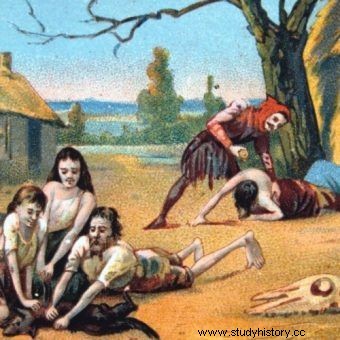
19th-century drawing showing the effects of famine in medieval Europe (source:public domain).
This seemingly innocent feeling, as Caparrós argues, is extremely dangerous when we are unable to satisfy it for a long time. It is this "true hunger" that has killed hundreds of millions of people over the centuries. Though there is no way to evaluate famine, some have made history particularly tragically.
Weapons more effective than the sword
Mad with rage, the Assyrian king Sennacherib was fed up with the constant rebellions. He decided to deal severely with the rebellious subjects. One of the greatest slaughters of antiquity - the killing of the Babylonians - was accomplished by starving the city's defenders.
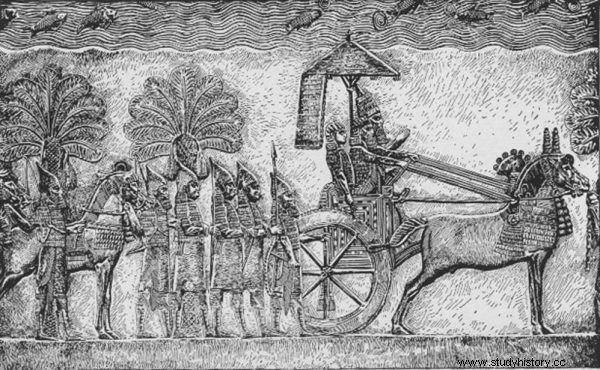
Bas-relief showing King Sennacherib at the head of his troops (source:public domain).
In 689 BC, the Assyrian army finally entered Babylon after a long siege. The streets were piled high with bodies that had not been buried for a long time. The surviving inhabitants groaned in pain and terror. Few, however, were able to escape. The exhausted and half-dead defenders could only wait for their enemy's swords to finish them off.
The Assyrians had no mercy, killing everyone without exception and destroying everything in their path. The number of victims of this bloodbath is unknown. However, it is known that approximately 200,000 people lived in Babylon at that time. Sennacherib himself stated:
WITH I attacked [the city of Babylon] like a hurricane and struck it down like a storm… I did not spare its inhabitants, neither old nor young; I covered its streets with their corpses. (…) I destroyed Babylon more than the flood did .
Forty years after these events, Babylon was again under attack. This time the Assyrian king Ashurbanipal attacked the city defended by his brother Shamash-shuma-ukin. During the four-year siege, the inhabitants clung to every possibility of survival.
In the last year that Ashurbanipal's troops surrounded the city, the situation was so hopeless that desperate people began to eat the meat of their fallen brothers. The plagues of the greatest murderer in history were to lead to many similar behaviors in the following epochs.
Executioner of Europe
At the beginning of the fourteenth century, the population of almost all Europe became painfully aware of this. It started with bad weather. In the fall of 1314, heavy rains caused European crops to sink into puddles. Then came the harsh winters. In 1315, the entire continent was starving.
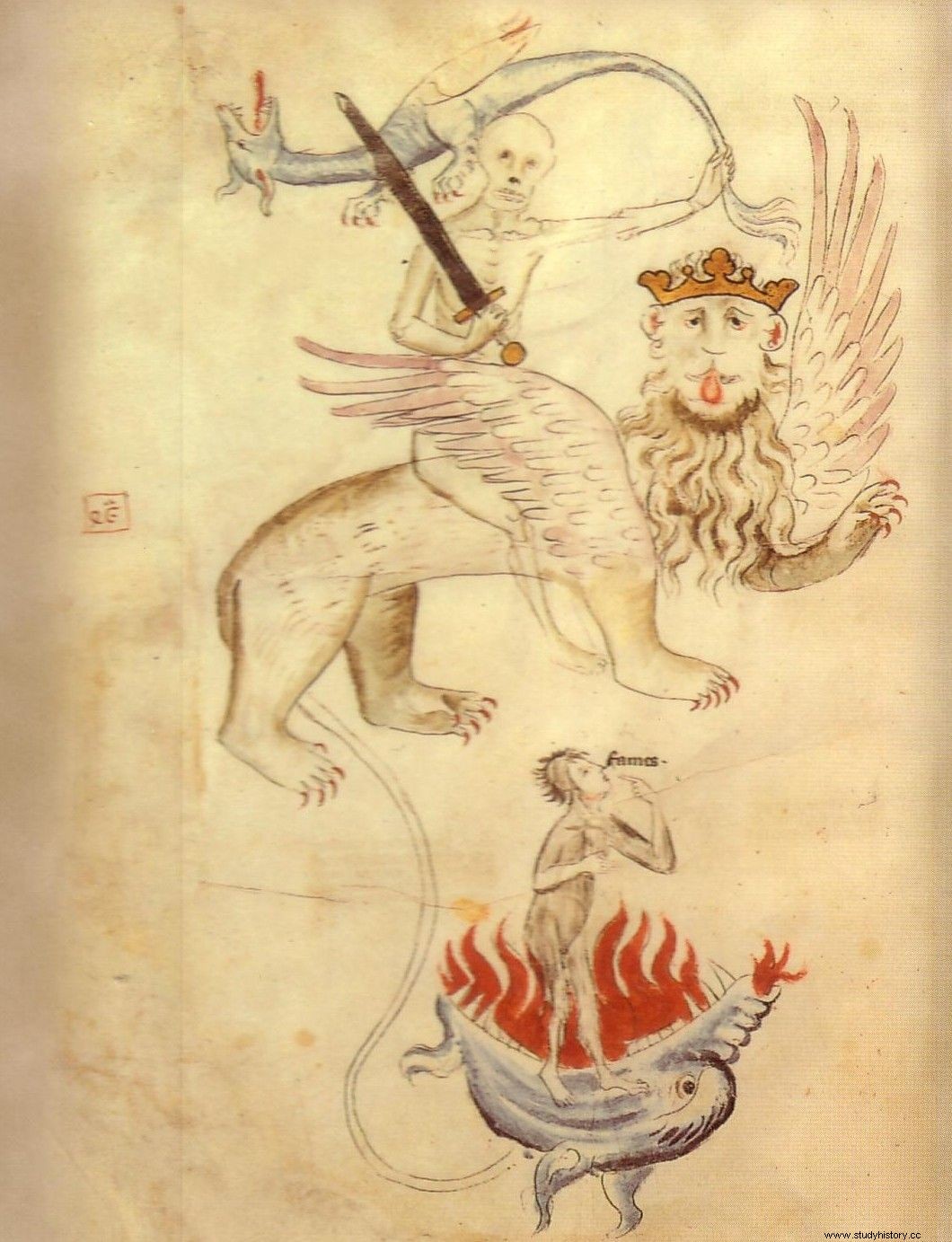
In the years 1315-1317, the famine cost the lives of as many as six million Europeans! Above, there is an illustration from the "Biblia Pauperum" depicting death and hunger (source:public domain).
The plague subsided after two years, but the scale of the tragedy was difficult to imagine, and its effects were felt by Europe for decades to come. It is no wonder, as about six million people, or nearly ten percent of Europeans of that time, died in a short time!
In the face of mass death, the faith and the Church experienced a serious crisis. Cannibalism has become commonplace. The cannibals did not always wait for the death of their comrades in misery. At any moment, you could be a "dinner" of a neighbor lurking in the alley or a family member mad with hunger. Death was literally everywhere.
No wonder then that people shouted from the pulpits about the fall of humanity. This situation was usually interpreted as a punishment for sins. When God saw that the world was too haughty, he sent hunger on the earth One of the witnesses of these events wrote.
Hunger born in fire
The turn of the 16th and 17th centuries was the beginning of another tragedy on a large scale. In 1600, Huaynaputina volcano erupted heavily in the Peruvian highlands. The dust discharged into the atmosphere polluted the air, which led to the so-called volcanic winter. Lowering the temperature stopped the vegetation of plants. The effects were felt on the other side of the world. Literally.
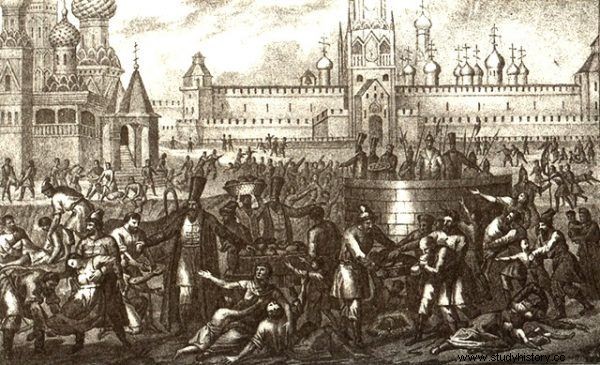
One hundred thousand people died of hunger in Moscow alone between 1601 and 1603. Above, a 19th-century illustration of Dantesque scenes taking place in the Russian capital.
The changes hit the population of Russia the hardest. In the land of the tsars, truly Dantean scenes took place. In Moscow, terrifying rumors began circulating that the fair offers special dumplings stuffed with meat ... of infants and underage children. The scale of infanticide has reached such alarming dimensions that it has become a fully socially acceptable phenomenon.
Some estimates say that between 1601 and 1603 nearly two million Russians, one third of the country's population, died! In Moscow alone, it was over a hundred thousand people.
Murderer of Ireland
Another nation to experience the killing famine is the Irish. The ordeal began in 1845 and continued for the next four years. The cause of the tragedy was the potato blight, which on a massive scale destroyed the cultivation of the plant, which is the basis of the local people's diet.
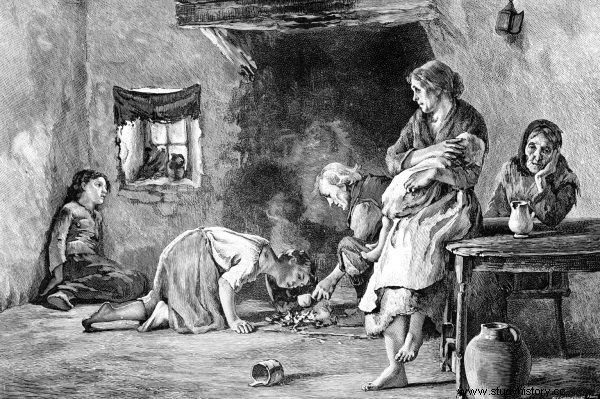
For the poor people of Ireland, the potato blight was actually a death sentence (source:public domain).
The most shocking of all was the attitude of some members of the British government. Ireland was believed to be overpopulated anyway, and hunger was the punishment for constantly rebelling against Queen Victoria.
Charles Edward Trevelyan , The Assistant Secretary of the Treasury responsible for coordinating the government's aid to Ireland, with these words summed up the tragedy: It was God's judgment that this catastrophe fell on the Irish in order to teach them a lesson. Therefore, this catastrophe should not be counteracted too much .
At least one million people died as a result of the plague, which was about ten percent of the population at that time. The second many have left the island . However, the tragedy that befell the Irish paled in comparison with the famine that was the work of totalitarian dictators.
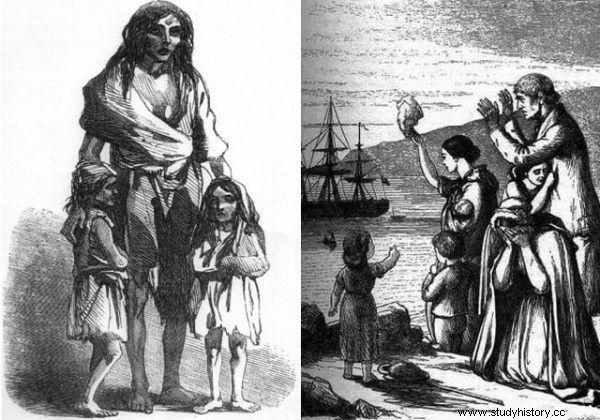
The famine of 1845-1849 cost the lives of about a million Irish people, while the same number had to leave the island, emigrating mainly to the United States (source:public domain).
Planned genocide?
Joseph Stalin intended to introduce the communist order by deed rather than word. The state needed hundreds of thousands of tons of food. Not to distribute it reasonably, but to export it. Mass collectivization was supposed to allow the Red Tsar to achieve this goal.
When planning the agricultural reform, the dictator realized that the mandatory food supply quotas would exceed the production capacity of the village. To meet the standards, people had to take their resources away from people.
Severe penalties were introduced - breaking five ears of corn was threatened with ten years in a labor camp. We did not have to wait long for the effects of such a policy. According to various estimates The Great Famine in Ukraine in 1932-1933 claimed from over three to even seven million human lives .
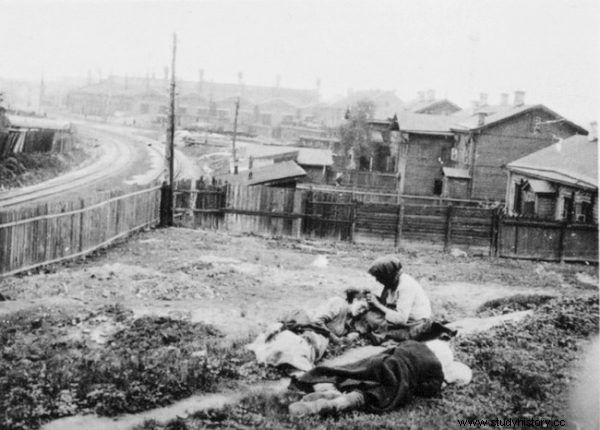
Stalin's cynical policy claimed the lives of millions of people in Soviet Ukraine (source:public domain).
Nadija Tokarenko from the village of Chupakhivka in the Kharkiv region recalls the horror of those days as follows:
They have set up a kind of orphanage in the village. The children were swollen, wounds, scabs, their bodies were bursting. (...) Once, the children suddenly fell silent, we turned to see what was happening, and they were eating the smallest Petka. Scabs on it tear out and eat. We took the baby away from its hungry mouths and cried.
A witness from the Zhytomyr oblast mentions the procedure of removing the bodies from the villages, which were then placed in collective pits. For each corpse they took, they were given bread and a bottle of vodka (daily). (...) There were cases when they took those who were still alive, so that tomorrow they would not come to the same place again - he reported.
Mao starves China
Another communist leader is an example of how one man's ill-considered decisions can contribute to the drama of hundreds of millions of people. In 1958, Mao Zedong started implementing a program known as the Big Leap Forward.
The dictator was convinced that the new assumptions would make China an economic power. In fact, they brought one of the greatest catastrophes in history to the nation. From then on, the peasants were to be concentrated in the great people's communes. The practices forced by Mao resulted in a shortage of food quickly. The Chinese ate grass soup, ground stalks, or grain chaff.
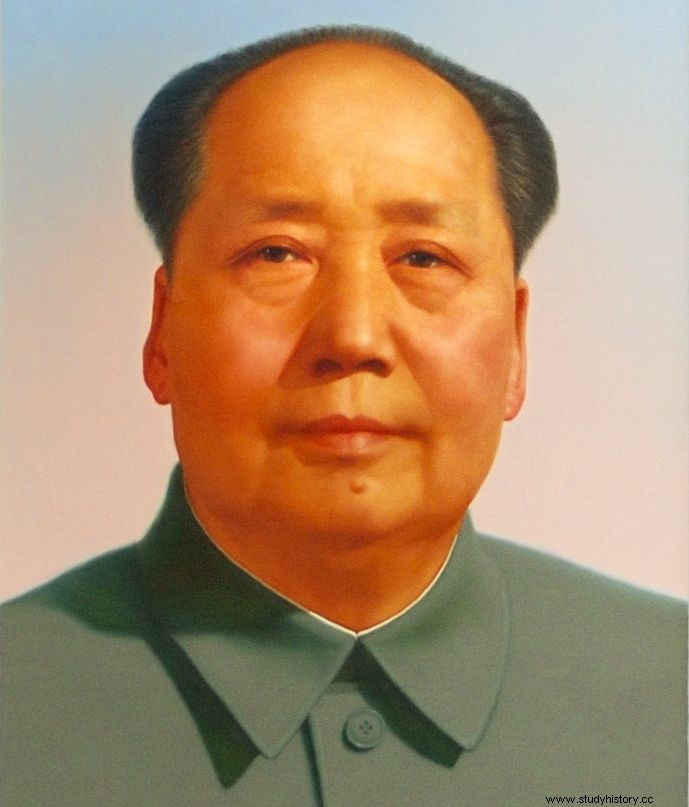
Mao Zedong's crazy ideas led to the death of tens of millions of people by starvation. The picture shows a portrait of a Chinese dictator by Zhang Zhenshi.
The famine caused by Mao's politics could have claimed over forty million people in four years . Some estimates are even more frightening - some historians speak of sixty million . These calculations are similar to some of the figures for the total number of victims of World War II.
Hunger today
In the 21st century, hunger still kills in a serial way. The greatest disasters are affecting Niger and South Sudan. Today more than 795 million people go hungry worldwide. Every day 25,000 people die from lack of food, which means over 9 million deaths annually.
As Martín Caparrós f argues in his book the act that tens of millions of men, women and children die of hunger each year is the scandal of our century. The journalist also notes that today there are basically no reasons for people to starve. Especially since w in its current state of development, world agriculture could easily feed twelve billion people . This is a true paradox of our time.
Bibliography:
- Judith M. Bennett, Warren Hollister, Medieval Europe:A Short History , New York 2006.
- Piotr Biziuk, Babylon 729-648 BC ., Warsaw 2005.
- Martín Caparrós, Hunger , transl. Marta Szafrańska-Brandt, Krakow 2016.
- Stanisław Grzybowski, History of Ireland, Wrocław 1977.
- Robert Kuśnierz, Ukraine in the years of collectivization and the Great Famine (1929-1933) , Toruń 2005.
- Sid Perkins, Disaster goes global:The eruption in 1600 of a seemingly quiet volcano in peru changed global climate and triggered famine as far away as Russia , "Science News", Vol. 174, No. 5, August 30, 2008
- Jakub Polit, China . Warsaw 2004.
- Symonye and Covetise, or On the Evil Times of Edward II , (in :) Medieval English Political Writing, edited by James M. Dean, Kalamazoo 1996.
- Great Famine in Ukraine 1932-1933. Multimedia exhibition of the Institute of National Remembrance [access:March 28, 2016].
